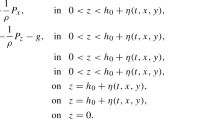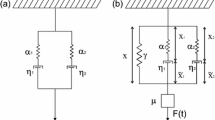Abstract
Effects of the viscosity, Earth rotation, and sphericity (beta-effect) on the long-wave dynamics are investigated based on the linear model. The basic equation for the complex amplitudes of gravitational long waves is obtained. It is shown that the viscosity plays a significant role in the long-wave dynamics. Stokes’ layer thickness is the criterion which separates two regimes of long-wave evolution: low viscosity and viscous flows. Two Stokes’ layers occur in the rotating fluid. The thickness of the first approaches to infinity as the frequency tends to inertial frequency. Considering the role of the Stokes’ layer as a criterion of viscosity influence, we can conclude that for the waves of the near-inertial frequency, viscosity always plays a significant role irrespective of ocean depths. The beta-effect leads to the planetary drift velocity occurrence in the equation. The planetary drift velocity can have either eastward or westward direction depending on the wave frequency. Thus, Earth sphericity causing the planetary drift plays a major role in the asymmetry of the eastward and westward directions in wave dynamics. Friction is another reason for the asymmetry of the eastward and westward directions in wave dynamics. Damping decrements of the westward and eastward waves differ with the biggest difference for waves with the near-inertial frequencies. Group velocities of eastward and westward waves are nonsymmetrical too. Moreover, in a certain range of the near-inertial frequencies, group velocities of both westward and eastward waves are directed exceptionally eastward. Thus, the beta-effect and fluid viscosity can be the reasons for the asymmetry of western and eastern bays in the tidal wave dynamics.






Similar content being viewed by others
References
Bowden KF (1988) Physical oceanography of coastal waters. Ellis Horwood Ltd, New York
Defant A (1961) Physical oceanography. Pergamon, New York
Djordjevic VD (1980) On the dissipation of interfacial and internal long gravity waves. J of Appl Math Phys(ZAMP) 31:318–331
Djordjevic VD (1983) On the effect of viscosity on some nonwave motions of liquids with the free surface. Acta Mech 48:219–226
Dronkers J J (1964) Tidal computations in rivers and coastal waters. Amsterdam
Eckart C (1960) Hydrodynamics of oceans and atmospheres. Pergamon
Ekman VW (1905) On the influence of the Earth’s rotation on ocean currents. Aroh math astron fhs 2:1–53
Friedrichs CT, Aubrey DG (1994) Tidal propagation in strongly convergent channels. J Geophys Res 99:3321–3336
Gerkema T, Shrira VI (2005) Near-inertial waves in the ocean: beyond the ‘traditional approximation’. J Fluid Mech 529:195–219
Gerkema T, Zimmerman JTF, Maas LRM, Van Haren H (2008) Geophysical and astrophysical fluid dynamics beyond the traditional approximation. Rev Geophys 46:RG2004
Gill AE (1982) Atmosphere-Ocean Dyn. Academic, NewYork
Grimshaw RHJ, Ostrovsky LA, Shrira VI, Stepanyants YA (1998) Long nonlinear surface and internal gravity waves in a rotating ocean. Surv Geophys 19:289–338
Harleman DRF (1966) Tidal dynamics in estuaries, part II: Real estuaries. In: Estuary and Coastline Hydrodynamics, edited by A.T. Ippen. McGraw-Hill, New York
Hunt JN (1964) Tidal oscillations in estuaries. Geophys J R Astron Soc 8:440–455
Hydrodynamics of Lakes (1984), Kolumban Hutter, Ed., Wien: Springer Verlag. 341 p. ISBN: 978–2–211-81812-1
Ippen AT (1966) Estuary and coastline hydrodynamics. McGraw Hill, New York
Jay DA (1991) Green’s law revisited: tidal long-wave propagation in channels with strong topography. J Geophys Res 96:20585–20598
Jelesnianski CP (1970) Bottom stress time-history in linearized equations of motion for storm surges. Mon Weather Rev 98:462–478
Jordan TP, Baker JR (1980) Vertical structure of time-dependent flow dominated by friction in a well-mixed fluid. J Phys Oceanogr 10:1091–1103
Kakutani T, Matsuuchi K (1975) Effect of viscosity on long gravity waves. J Phys Soc Jpn 39:237–246
Lanzoni S, Seminara G (1998) On tide propagation in convergent estuaries. J Geophys Res 103:30793–30812
Lanzoni S, Seminara G (2002) Long-term evolution and morphodynamic equilibrium of tidal channels. J Geophys Res 107:1–13
Le Blond PH (1978) On tidal propagation in shallow rivers. J Geophys Res 83:4717–4721
Le Blond PH, Mysek LA (1978) Waves in the ocean. Elsevier, Amsterdam
Lighthill J (1978) Waves in fluids. Univ. Press, Cambridge
Maz’ya VG (1972) On a degenerating problem with directional derivative. Math USSR-Sb 16(3):429–469
Mofjeld HO (1980) Effects of vertical viscosity on Kelvin waves. J Phys Oceanogr 10:1039–1050
Nakaya C (1974) Spread of fluid drops over a horizontal plane. J Phys Soc Jpn 37:539–543
Pedlosky J (1982) Geophysical fluid dynamics. Springer-Verlag, New York
Perroud P (1959) The Propagation of tidal waves into channels of gradually varying cross section. Technical memorandum. Beach Erosion Board. Washington, D. C. 112
Platzman GW (1963) The dynamical prediction of wind tides on Lake Erie. The dynamical prediction of wind tides on Lake Erie. American Meteorological Society, Boston, MA, pp 1–44
Poincare H. (1910) Lecons de Mecanique celeste. III. Paris
Prandle D (1985) Classification of tidal response in estuaries from channel geometry. Geophys J R Astron Soc 80:209–221
Prandle D (2009) Estuaries. Dynamics, mixing, sedimentation and morphology. Univ. Press, Cambridge
Prandle D, Rahman M (1980) Tidal response in estuaries. J Phys Oceanogr 10:1552–1573
Proudman J (1925) Tides in a channel. Philos Mag (49)6:465
Proudman J (1953) Dynamical oceanography. London
Savenije HHG (1992) Lagrangian solution of St. Venant's equations for an alluvial estuary. J Hydraul Eng 118:1153–1163
Savenije HHG (2005) Salinity and tides in alluvial estuaries. Elsevier, Amsterdam
Savenije HHG, Veling EJM (2005) The relation between tidal damping and wave celerity in estuaries. J Geophys Res 110:1–10
Taylor GI (1922) Tidal oscillations in gulfs and rectangular basins. Proc Lond Math Soc 20:148–181
Van Rijn LC (2011) Analytical and numerical analysis of tides and salinity in estuaries. Pt I. Tidal wave propagation in convergent estuaries. Ocean Dyn 61:1719–1741
Welander P (1957) Wind action on a shallow sea: some generalizations of Ekman’s theory. Tellus 9:45–52
Zyryanov V N (1995) Topographic eddies in sea current dynamics. Moscow (in Russian)
Zyryanov VN (2014) Nonlinear pumping in oscillatory diffusive processes: the impact on the oceanic deep layers and lakes. Commun Nonlinear Sci Numer Simul 19:2131–2139
Zyryanov VN, Chebanova MK (2016) Hydrodynamic effects at the entry of tidal waves into estuaries. Water Res 43:621–628
Zyryanov VN, Chebanova MK (2017a) Dissipative-convergent intermittency in dynamics of tidal waves in estuaries. Fluid Dynamics 52:722–732
Zyryanov VN, Chebanova MK (2017b) Experimental studies of the right and left bays asymmetry in the tidal waves dynamics. Process Geo-media 1(10):410–418
Acknowledgments
The authors are grateful to the anonymous reviewer for the detailed analysis of our paper and very useful comments and discussions.
Funding
This work was supported by the Russian Foundation for Basic Research (RFBR project 16-05-00209 А).
Author information
Authors and Affiliations
Corresponding author
Additional information
Responsible Editor: Dirk Olbers
Rights and permissions
About this article
Cite this article
Zyryanov, V.N., Chebanova, M.K. Viscous waves on a beta-plane and its zonal asymmetry. Ocean Dynamics 69, 427–441 (2019). https://doi.org/10.1007/s10236-019-01253-7
Received:
Accepted:
Published:
Issue Date:
DOI: https://doi.org/10.1007/s10236-019-01253-7




